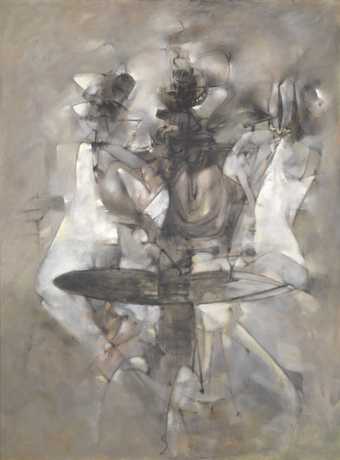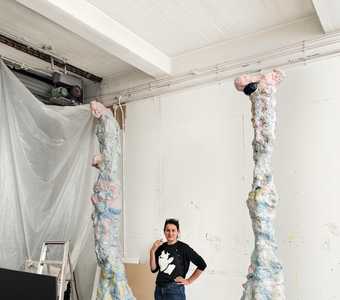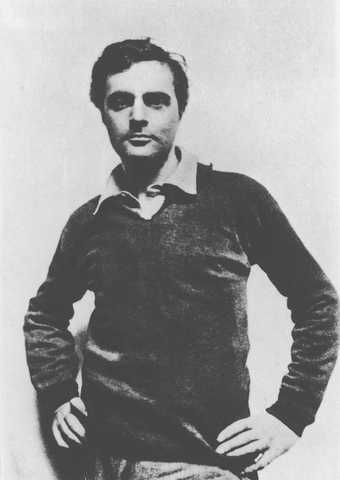
Dorothea Tanning, A Mi-Voix 1958, oil paint on canvas, 130.2 x 97.2 cm
© DACS, 2017
A gleaming row of teeth – sickle smile – waning crescent – curling grin, tilted to the right – or is it to the left? – depending on your perspective. ‘My chagrin’, I used to say as a child, when asked to bare the pearly whites. I did not see the teeth at first, nor the dark faces with their hoods – or is it hats? The smooth, shapely bodies – or are they swollen?; the shimmering, opalescent textiles – or spectres?; the elegant legs and well-heeled feet beneath a cafe table – or the dark fragment of a large spinal column and pelvis.
A Mi-Voix speaks in a half-whisper – literally, ‘at half-voice’ – as though this is a place at which one might arrive then pause, hover, eddy. Mi-voix, without the prefix of ‘A’, could be read as ‘undertone: an underlying quality or feeling’, and also, ‘a subdued or muted tone of sound or colour’; specifically, a colour seen through and modifying another colour. Dorothea Tanning wrote of her painting that she wanted to ‘paint a white and grey picture that would still have colour in its veins as we have blood under our winter-white skin’. Painting as organic material, as living thing, pulsing veins tender to touch. There is a sliding on the scale; there is a humming in the air and a thrumming in the heart, which beats – sotto voce – a fractured, arrhythmic line.
'I did not see the teeth at first; I could not hear the sinister stutter.'
There are words inside words and images inside images. Tanning’s A Mi-Voix, with its distorted, whispering women, twists and turns in three dimensions. It ricochets off the walls and soft forms of her later installation work, Hôtel du Pavot, Chambre 202 1970–3, in which women’s fabric bodies, nude and headless, tear through the genteel patterns of the wallpaper, swell and tumble out of a fireplace and a chair, swoon backwards over a table. One wall figure is seen from behind, her torso studded with prominent vertebrae made from tennis balls pressed beneath the tightly stretched fabric. Because there is always something just under the surface, pushing and pushing until it starts to crack, peel, tear. Through these rends in material seep other works and words, whispering at half-voice, rising in pitch and volume.
‘Then at one point I did not need to translate the notes; they went directly to my hands’, Francesca Woodman hand-scrawled across the white space below one of her own black-and-white photographs, in which she crouches, nude on bare floorboards, braced with splayed hands, arms at 45-degree angles, against the grubby wall in front of her. Her head is forward and down, the hair-draped nape of neck just visible; around her back curls an enormous piece of thick paper, as though a parchment wing has sloughed from the walls to encircle her slender form, shielding it from view.
‘BE CALM’ and ‘ART IS A GUARANTY OF SANITY’ and
‘I want to get
I want to keep
I want to tell
I want to see
I want to learn
I want to know
I want to know’
wrote Louise Bourgeois, whose women bend and bow their bodies, lean against walls, hang suspended from wires, arch hysterically through the air; whose forms recall Tanning’s – soft, pink and bulging, they embrace and slumber en masse, with silent narratives hanging everywhere in the still, surrounding atmosphere.
In her book of engravings, He Disappeared into Complete Silence, Bourgeois writes of a small town in the mountains of France, in which sugar is a rare commodity; every year, for Christmas, each child is given a small piece: ‘One little girl I knew when she was my mother was very fond and guarded hers jealousy. She made a hole in the earth to hide her piece of sugar but every time she forgot the earth is damp.’ The plate on the opposing page shows a dark, amorphous figure swirling at the centre of a three-storied house, which lists in dark incisions to the right.
Seeping into the same ground, bouncing off the same walls, swinging on the same hinge. In Sylvia Plath’s poem ‘Zoo Keeper’s Wife’, the titular narrator admonishes her husband: ‘Your two-horned rhinoceros opened a mouth / Dirty as a bootsole and big as a hospital sink / For my cube of sugar: its bog breath / Gloved my arm to the elbow.’ In a hypnagogic, hallucinatory state, the wife sees her belly as a silk stocking in which the heads and tails of her sisters decompose: ‘Should I stir, I think this pink and purple plastic/Guts bag would clack like a child’s rattle, / Old grievances jostling each other, so many loose teeth.’
Zoos are for teeth-baring and snarling, pacing along the perimeter fence and letting loose the occasional shriek that is glinting and sharp, like a razor clam. Tanning’s fellow Surrealist, Leonora Carrington, was taken by her mother to the zoo in Blackpool, a rare and cherished a treat, to celebrate her first Communion. Carrington believed that every person was in possession of an ‘inner bestiary’, and that the ability to transform – to slip, slither and shape shift – was a source of revelatory power: ‘The matter of our bodies’, she said, ‘like everything we call matter, should be thought of as thinking substance.’
The connections drawn here do not form a circle, but a fault line of inversions from which echoes peel off in sheets and jagged edges overlap. Half- voiced whispers ring in the ears and reflect the battered light of uneven surfaces. In A Mi-Voix, I did not see the teeth at first; I could not hear the sinister stutter. I thought the image was an infinite fractal of twisted veins blue-black and mouthfuls purple – a series of reverberations suspended in space and time.
A Mi-Voix was presented by William N. Copley in 1959 and is on display at Tate Modern.
Emily LaBarge is a Canadian writer based in London, where she teaches at the Royal College of Art.




